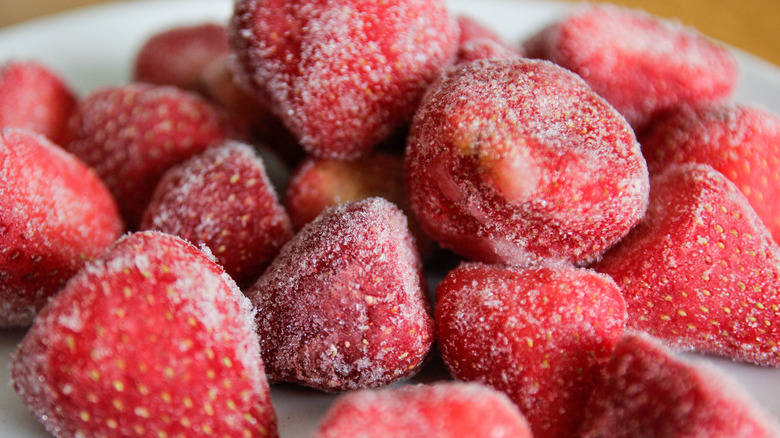How To Defrost Frozen Strawberries Without Making A Soggy Mess
According to a YouGov poll, strawberries (which aren't actually considered a type of berry) are the most popular fruit in the United States. However, fresh strawberries can be on the pricier side, especially when they're out of season. This is when many strawberry fans turn to frozen strawberries as an affordable alternative. Unfortunately, these frozen strawberries become disappointing if they aren't properly thawed. All too often, you're left with mushy strawberries swimming in their own juice.
When strawberries thaw, they excrete juice and become soft because their cell walls ruptured during freezing. To some degree, this softer texture is unavoidable. However, there are some thawing methods that limit how soft and soggy the strawberries become. One of the best methods is to place the frozen strawberries in the fridge for about eight hours or overnight. The cool temperatures in this environment help the strawberries retain their texture as they thaw.
I've personally found that, while this method works, an even more efficient way to defrost strawberries is to put them into a strainer with a bowl underneath before placing the whole thing into the fridge. As the strawberries thaw, the juice will strain into the bowl, preventing the strawberries from reabsorbing too much juice and becoming soggy. As a bonus, you'll now have strawberries for your intended purpose as well as a strawberry juice that can be used to make flavored simple syrups. If you don't have eight hours to wait for them to thaw, a quicker method is to transfer the frozen strawberries to a resealable bag and immerse them in a bowl of cold water for about two hours. Alternatively, you can run cold water over each strawberry for about eight seconds or until it softens.
The microwave should be your last resort
While microwaving frozen strawberries will thaw them, it tends to create very soggy strawberries. (The heat from the microwave causes the strawberries to break down quickly.) If a microwave is the only option you have available for thawing frozen strawberries, place 1 cup of the strawberries on a microwave-safe plate lined with paper towel and microwave in 30 second increments for up to two minutes or until the strawberries are thawed. Immediately remove the strawberries from the microwave and take them off the paper towel to prevent further exposure to heat.
If you're following a recipe that calls for heating or breaking down strawberries in some way (for example, when making syrups, jams, or no-bake strawberry lemonade pie) then using a microwave to thaw the frozen strawberries will help speed the cooking process. However, if the recipe calls for fresh whole or sliced strawberries, you are better off using strawberries that've been thawed using one of the aforementioned techniques. (You can even leave them partially frozen to ensure they don't fall apart.)
Thawed strawberries should not be used when you're making things like chocolate-covered strawberries. That's because, in this dish and others like it, the crisp, firm texture of fresh strawberries is an essential component. No matter how you thaw them, frozen strawberries will never quite be able to replicate that texture.

